|
|
Front
View
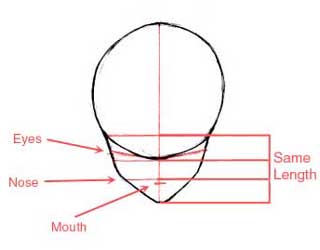 Step
1: Step
1:
Most Dragonball Z characters can be
drawn using these basic shapes and proportions.
Dragonball Z characters all have similarly constructed
faces: they have large foreheads, slanted, triangular
eyes, and small lower faces. Once you see how the basic
face is proportioned, it should be easier to draw
whichever character you like. Begin by drawin a large,
slightly elongated circle for the forehead. Draw the
lower half of the face and divide it up with lightly
drawn guidelines as shown. Notice that the lower half of
his face can be divided up into equal sections; the main
horizontal guidelines are equidistant from each other.
Draw the slanted guidelines for the eyes, and sketch the
position of the mouth (which should be directly below
the guideline for the nose). Make sure all the
guidelines are drawn lightly, because you are going to
erase them later on. |
|
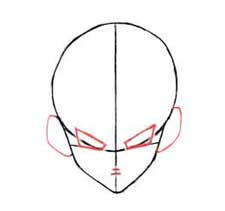 Step 2: Step 2:
Erase some of the unnecessary
guidelines. Draw the outline of the eyes, which are just
blocky, angled trapezoids. Make sure the bottom of the
eyes line up with the slanted guideline you drew in
earlier. |
|
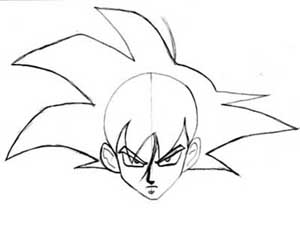
Step 3:
Next, sketch the outline of his
hair. The hair is very large and spiky; notice how it
smooths out slightly on the right side (our right, not
his) of his head, though. Add more detail to his eyes
and ears. When drawin his eyebrows, make sure that they
rest directly above his eyes. Draw the nose and mouth
next, making them very small and close together. The
nose should be sort of like a blocky 'L' or
wedge. |
|
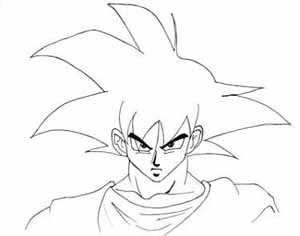
Step 4:
Next, erase all the guidelines. Add
the shading under his eyes and mouth, and add detail to
his ears. Next, draw the neck, muscles, and clothing.
DBZ necks are usually pretty wide, so make sure the neck
starts just beneath the ears. Erase any unwanted lines
and clean up your sketch. |
|
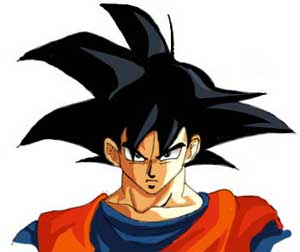 Step 5: Step 5:
Take your final sketch and color or
shade it however you like. Notice that the shading on
his hair is very subtle, and gives the otherwise flat
spikes more dimension, so you know his hair doesn't just
go straight back like Ryoko's (from Tenchi Muyo), it
kind of sticks out in all directions.
^_^ |
|
3/4
View
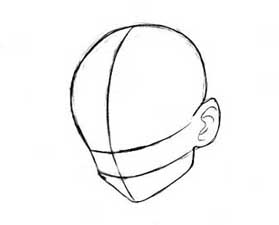 Step
1: Step
1:
Next, we'll draw the 3/4 view. These
proportions will work for other DBZ characters, too.
Draw a large circle, then add the lower half of the face
and divide the shapes up with guidelines.
These are pretty much the same
shapes as in the front view, except they have been
rotated downwards and to the side. The 3/4 view has less
guidelines than the front view, but that's only because
adding them would be unneccesary at this angle. We'll
only be using the guidelines for the eyes, nose, and the
central guideline that runs from the forehead to the
chin. |
|
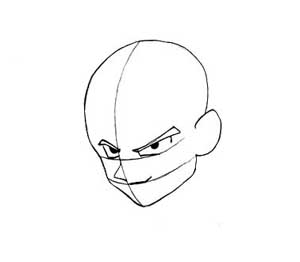 Step 2: Step 2:
Next, use the upper horizontal
guideline to draw in the eyes and eyebrows. Draw the
nose and mouth, making sure to draw the mouth very close
to the nose. The features of the face should have very
sharp angles. Notice that while on the front view his
nose looks small, on the 3/4 view it is much longer and
pointed. |
|
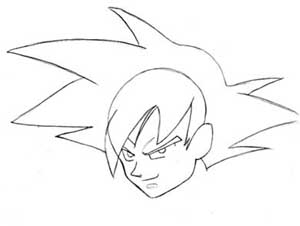 Step 3: Step 3:
Erase all the guidelines. Draw the
basic shape of his hair, making it very thick and
rounded. Notice again that the hair flattens and rounds
out on the right side of his head. Add his pupils, draw
in the eyebrow ridges above his eyes, and shade beneath
his mouth. |
|
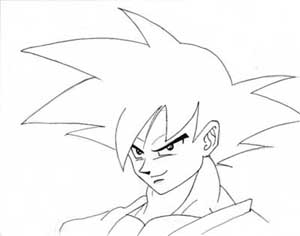
Step 4:
Erase all unnecessary lines. Add the
detail in his ears, and add shading to his eyes. I added
a few light glares to his pupils out of habit, even
though DBZ characters almost never have such details on
the eyes. You can leave them out if you like, but I
think they look fine. Again, his neck muscles are very
large, so start them just below the ear. Add the rest of
his muscles and clothes, then clean up your sketch and
prepare it for the final
draft. |
|
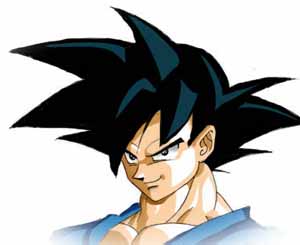 Step 5: Step 5:
Now that you have drawn his face,
you can shade and color it however you like. Notice
again that the subtle shading on the hair shows that it
sticks out in various directions rather than just going
straight back. Make sure to try to include this if you
shade your picture. |
Super Saiyajin Form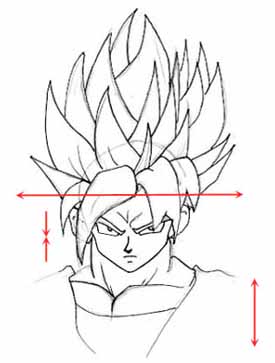
Goku, like several other characters
on DBZ, can transform into a Super Saiyajin (yes, that
is an accepted spelling, so stop bugging me about it).
From what I could discern from the internet, he has at
least three or four different forms, but I really don't
have the patience to go through each of them. The
differences are slight, anyway, and if you know which
features to exaggerate, its not that much of a
problem.
To draw Goku (or anyone, for that
matter) in Super Saiyajin form, you'll have to make a
few adjustments to his face, as well as his hair. His
head and body should be wider, while the face itself is
smaller. The features are more slanted and grouped
closer together. The lines of his face will be much more
sharp and slanted, and his eyes will be much more
narrow. The chest and arm muscles are increasingly
larger and rounder for every further transformation.
These adjustments can be used on any Super
Saiyajin.
For the hair, basically just draw a
series of sharply angled, pointed spikes that extrude
from his scalp. It helps to draw the outline of his
head, as shown in this picture, so you can tell where
the hair should go. It's easy to make it too big or too
small if you don't know where to position it. Even
though it's spiky, make the hair full and rounded,
rather than just using straight spikes. All the spikes
should curve inward, not just stick
straight. |
|
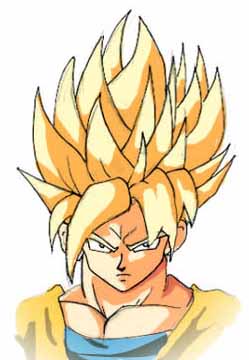 Here's what the
hair should look like when the guideline for the back of
the head has been removed and the hair has been shaded.
I did a sloppy job of coloring the hair, though; the
shading should be much less rounded than it is in this
particular picture. You can look at other pictures of
him on the internet or elsewhere for further
reference. Here's what the
hair should look like when the guideline for the back of
the head has been removed and the hair has been shaded.
I did a sloppy job of coloring the hair, though; the
shading should be much less rounded than it is in this
particular picture. You can look at other pictures of
him on the internet or elsewhere for further
reference.
|
| | |